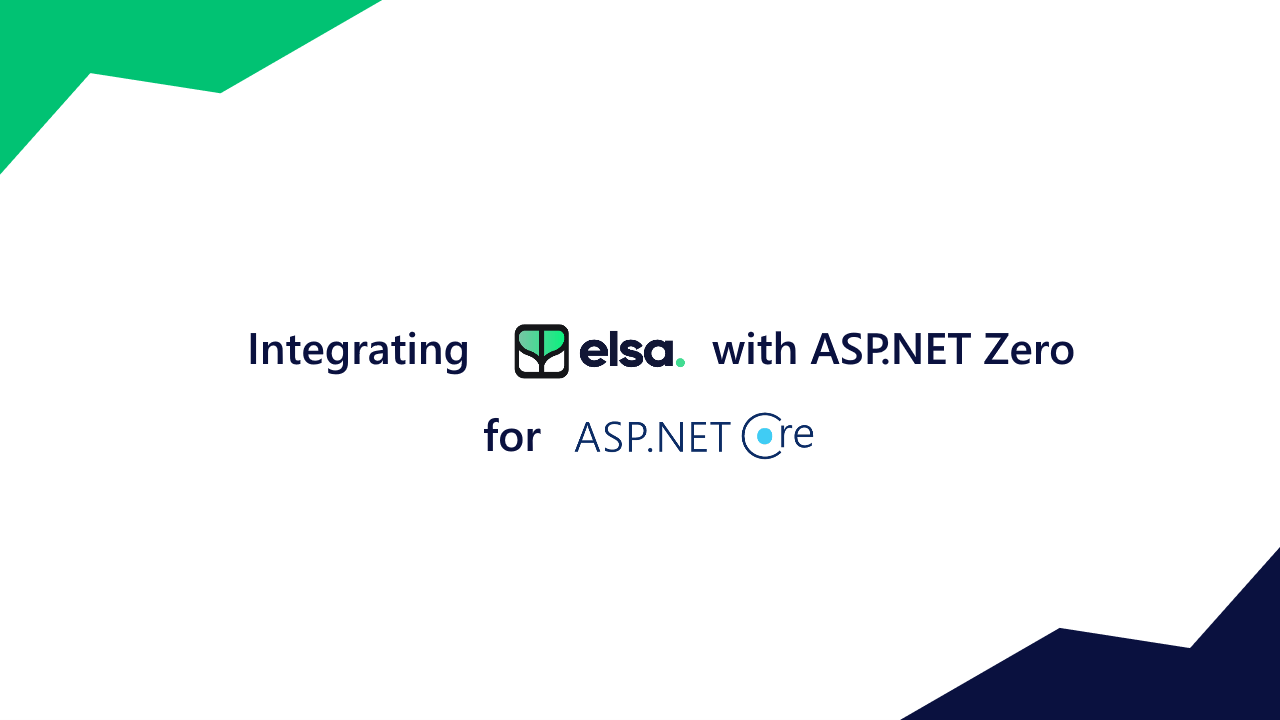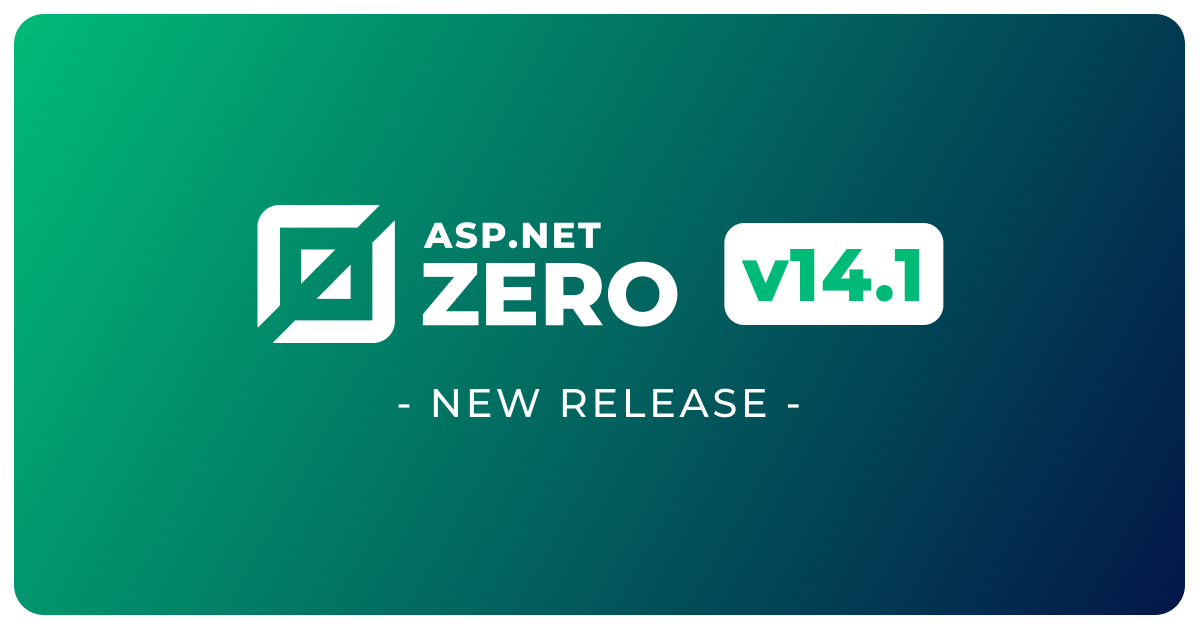Integrating ELSA with ASP.NET Zero
Elsa is a great open source .NET Standard workflows library. Elsa allows creation of workflows by code, by JSON definition or by its workflow designer UI. In this document, we will basically integrate Elsa with ASP.NET Zero and create a simple workflow following official Elsa Dashboard + Server document.
Fully integrated Elsa sample project can be found on GitHub.
Create Project
In order to start integrating Elsa with ASP.NET Zero, first follow ASP.NET Zero's Getting Started document and create a new project.
Adding Elsa Packages
After creating the empty project, we need to add required Elsa NuGet packages to our project. Elsa document uses Elsa.Persistence.EntityFramework.Sqlite for persistence but we will use Elsa.Persistence.EntityFramework.SqlServer because ASP.NET Zero use SQL Server by default. So, add packages below to your *.Web.Mvc project.
- Elsa
- Elsa.Activities.Http
- Elsa.Activities.Temporal.Quartz
- Elsa.Persistence.EntityFramework.SqlServer
- Elsa.Server.Api
- Elsa.Designer.Components.Web
Configuring Elsa
ConfigureServices Method
After adding Elsa NuGet packages, we need to configure Elsa in Startup.cs. So, open Startup.cs under .Web.Mvc/Startup/ and configure it as shown below;
public IServiceProvider ConfigureServices(IServiceCollection services)
{
ConfigureElsa(services);
// Existing code blocks
}
private void ConfigureElsa(IServiceCollection services)
{
services.AddElsa(elsa =>
{
elsa
.UseEntityFrameworkPersistence(ef =>
ef.UseSqlServer(_appConfiguration.GetConnectionString("Default"))
)
.AddConsoleActivities()
.AddHttpActivities(_appConfiguration.GetSection("Elsa").GetSection("Server").Bind)
.AddQuartzTemporalActivities()
.AddJavaScriptActivities()
.AddWorkflowsFrom<Startup>();
elsa.UseAutoMapper(() => { });
}
);
// Elsa API endpoints.
services.AddElsaApiEndpoints();
services.Configure<ApiVersioningOptions>(options =>
{
options.UseApiBehavior = false;
});
services.Configure<RouteOptions>(options =>
{
options.LowercaseUrls = false;
});
// For Elsa Dashboard.
services.AddRazorPages();
// Remove ABP filter and add Elsa special filter
services.PostConfigure<MvcOptions>(options =>
{
ReplaceResultFilter(options);
});
}
Note: ReplaceResultFilter is explained in the next section.
In this configuration, we are configuring Elsa to use existing ASP.NET Zero database and we configure Elsa with Default connection string. In order for this configuration to work, we need to add below section to appsettings.json.
"Elsa": {
"Server": {
"BaseUrl": "https://localhost:44302"
}
}
This will allow Elsa to use ASP.NET Zero application for handling HTTP activities.
There are some special configuration points here which doesn't exist in default Elsa document. Let's take a look at those sections one by one;
AutoMapper
elsa.UseAutoMapper(() => { });
Both Elsa and ASP.NET Boilerplate creates a MapperConfiguration and uses it to create an IMapper. Because of this, if we don't add this line to Elsa configuration, the app will only use Elsa's AutoMapper configuration. But, after making this configuration, we need to configure Elsa's AutoMapper mappings in our app manually. In order to do this, go to *WebMvcModule and add below lines to its PreInitialize method.
// ELSA AutoMapper
Configuration.Modules.AbpAutoMapper().Configurators.Add(config =>
{
// AutoMapperProfile
config.CreateMap<IWorkflowBlueprint, WorkflowBlueprintModel>();
config.CreateMap<IWorkflowBlueprint, WorkflowBlueprintSummaryModel>();
config.CreateMap<IActivityBlueprint, ActivityBlueprintModel>().ConvertUsing<ActivityBlueprintConverter>();
config.CreateMap<ICompositeActivityBlueprint, CompositeActivityBlueprintModel>();
config.CreateMap<IConnection, ConnectionModel>().ConvertUsing<ConnectionConverter>();
config.CreateMap<WorkflowInstance, WorkflowInstanceSummaryModel>();
config.CreateMap<WorkflowDefinition, WorkflowDefinitionSummaryModel>();
// CloningProfile
config.CreateMap<WorkflowDefinition, WorkflowDefinition>();
config.CreateMap<WorkflowInstance, WorkflowInstance>();
config.CreateMap<WorkflowDefinition, WorkflowDefinitionVersionModel>();
});
API Versioning
services.AddElsaApiEndpoints();
services.Configure<ApiVersioningOptions>(options =>
{
options.UseApiBehavior = false;
});
services.Configure<RouteOptions>(options =>
{
options.LowercaseUrls = false;
});
ASP.NET Zero doesn't support API versioning and Elsa uses it by default. But, disabling UseApiBehavior makes ASP.NET Zero and Elsa to work together. AddElsaApiEndpoints configures LowercaseUrls of RouteOptions to true but ASP.NET Zero requires case sensitive URLs. So, we are converting LowercaseUrls of RouteOptions to false.
Result Filtering
services.PostConfigure<MvcOptions>(options =>
{
ReplaceResultFilter(options);
});
ASP.NET Zero wraps JSON results by default and adds some additional fields to JSON result. The actual result is accessed by result property of the returned JSON result. But, Elsa doesn't work this way, so we should ignore result wrapping for Elsa's controllers. Unfortunately, ASP.NET Zero doesn't provide an easy configuration for doing that. Because of that, we need to replace default result filter with our own custom result filter using the configuration above.
Here is the content of ReplaceResultFilter method;
private void ReplaceResultFilter(MvcOptions options)
{
for (var index = options.Filters.Count - 1; index >= 0; --index)
{
if (options.Filters[index] is ServiceFilterAttribute &&
((ServiceFilterAttribute) options.Filters[index]).ServiceType != typeof(AbpResultFilter))
{
continue;
}
options.Filters.Insert(index, new ServiceFilterAttribute(typeof(ElsaResultFilter))
{
Order = 0
});
options.Filters.RemoveAt(index + 1);
break;
}
}
This method replaces AbpResultFilter with ElsaResultFilter. Here is the content of ElsaResultFilter;
using Elsa.Server.Api.Endpoints.Activities;
public class ElsaResultFilter : IResultFilter, ITransientDependency
{
private readonly IAbpAspNetCoreConfiguration _configuration;
private readonly IAbpActionResultWrapperFactory _actionResultWrapperFactory;
public ElsaResultFilter(IAbpAspNetCoreConfiguration configuration,
IAbpActionResultWrapperFactory actionResultWrapper)
{
_configuration = configuration;
_actionResultWrapperFactory = actionResultWrapper;
}
public virtual void OnResultExecuting(ResultExecutingContext context)
{
if (!context.ActionDescriptor.IsControllerAction())
{
return;
}
var controller = context.Controller;
controller.GetType().GetAssembly();
if (controller.GetType().Assembly == typeof(List).Assembly)
{
return;
}
var methodInfo = context.ActionDescriptor.GetMethodInfo();
var wrapResultAttribute =
GetSingleAttributeOfMemberOrDeclaringTypeOrDefault(
methodInfo,
_configuration.DefaultWrapResultAttribute
);
if (!wrapResultAttribute.WrapOnSuccess)
{
return;
}
_actionResultWrapperFactory.CreateFor(context).Wrap(context);
}
public void OnResultExecuted(ResultExecutedContext context)
{
}
public TAttribute GetSingleAttributeOfMemberOrDeclaringTypeOrDefault<TAttribute>(MemberInfo memberInfo, TAttribute defaultValue = default(TAttribute), bool inherit = true)
where TAttribute : class
{
return memberInfo.GetCustomAttributes(true).OfType<TAttribute>().FirstOrDefault()
?? memberInfo.ReflectedType?.GetTypeInfo().GetCustomAttributes(true).OfType<TAttribute>().FirstOrDefault()
?? defaultValue;
}
}
Note:
using Elsa.Server.Api.Endpoints.Activities;is required forListclass.
Configure Method
The additions of Configure method are shown in the code block below;
public void Configure(IApplicationBuilder app, IWebHostEnvironment env, ILoggerFactory loggerFactory)
{
// existing code blocks
app.UseStaticFiles();
// ELSA
app.UseHttpActivities();
app.UseRouting();
// existing code blocks
app.UseEndpoints(endpoints =>
{
// existing code blocks
// For Dashboard.
endpoints.MapFallbackToPage("/_Host");
});
// existing code blocks
}
There are two additions here;
app.UseHttpActivities();this line allows Elsa to handle HTTP request and execute if there are any workflows related to HTTP activities.endpoints.MapFallbackToPage("/_Host");this line redirects all not found requests to_Host.cshtmlpage which we will create in the next section. This page will contain Elsa Dashboard source code.
Elsa Controllers
By default Elsa controllers are not registered in ASP.NET Zero's dependency injection system. In order to do that, we must register Elsa Conrollers as shown below in the Initialize method of the MVC Wed Module;
public override void Initialize()
{
// existing code blocks
// Register controllers inside ELSA
Register(typeof(Elsa.Server.Api.Endpoints.WorkflowDefinitions.List).GetAssembly());
Register(typeof(Elsa.Server.Api.Endpoints.WorkflowDefinitions.Save).GetAssembly());
}
private void Register(Assembly assembly)
{
//Controller
IocManager.IocContainer.Register(
Classes.FromAssembly(assembly)
.BasedOn<Controller>()
.If(type => !type.GetTypeInfo().IsGenericTypeDefinition && !type.IsAbstract)
.LifestyleTransient()
);
IocManager.IocContainer.Register(
Classes.FromAssembly(assembly)
.BasedOn<ControllerBase>()
.If(type => !type.GetTypeInfo().IsGenericTypeDefinition && !type.IsAbstract)
.LifestyleTransient()
);
//Razor Pages
IocManager.IocContainer.Register(
Classes.FromAssembly(assembly)
.BasedOn<PageModel>()
.If(type => !type.GetTypeInfo().IsGenericTypeDefinition && !type.IsAbstract)
.LifestyleTransient()
);
//ViewComponents
IocManager.IocContainer.Register(
Classes.FromAssembly(assembly)
.BasedOn<ViewComponent>()
.If(type => !type.GetTypeInfo().IsGenericTypeDefinition)
.LifestyleTransient()
);
}
Elsa Dashboard
In order to add Elsa Dashboard into ASP.NET Zero, create a folder named Pages under the MVC project and create a razor page named _Host.cshtml with the content below;
@page "/"
@{
var serverUrl = $"{Request.Scheme}://{Request.Host}";
}
<!DOCTYPE html>
<html lang="en">
<head>
<meta charset="utf-8"/>
<meta name="viewport" content="width=device-width, initial-scale=1.0"/>
<title>Elsa Workflows</title>
<link rel="icon" type="image/png" sizes="32x32" href="/_content/Elsa.Designer.Components.Web/elsa-workflows-studio/assets/images/favicon-32x32.png">
<link rel="icon" type="image/png" sizes="16x16" href="/_content/Elsa.Designer.Components.Web/elsa-workflows-studio/assets/images/favicon-16x16.png">
<link rel="stylesheet" href="/_content/Elsa.Designer.Components.Web/elsa-workflows-studio/assets/fonts/inter/inter.css">
<link rel="stylesheet" href="/_content/Elsa.Designer.Components.Web/elsa-workflows-studio/assets/styles/tailwind.css">
<script src="/_content/Elsa.Designer.Components.Web/monaco-editor/min/vs/loader.js"></script>
<script type="module" src="/_content/Elsa.Designer.Components.Web/elsa-workflows-studio/elsa-workflows-studio.esm.js"></script>
</head>
<body class="h-screen" style="background-size: 30px 30px; background-image: url(/_content/Elsa.Designer.Components.Web/elsa-workflows-studio/assets/images/tile.png); background-color: #FBFBFB;">
<elsa-studio-root server-url="@serverUrl" monaco-lib-path="_content/Elsa.Designer.Components.Web/monaco-editor/min">
<elsa-studio-dashboard></elsa-studio-dashboard>
</elsa-studio-root>
</body>
</html>
This helper class, named CurrentDirectoryHelpers, is crucial for resolving issues related to embedded static files, specifically when using ASP.NET Zero with Elsa's dashboard styles and scripts.
public class CurrentDirectoryHelpers
{
internal const string AspNetCoreModuleDll = "aspnetcorev2_inprocess.dll";
[System.Runtime.InteropServices.DllImport("kernel32.dll")]
private static extern IntPtr GetModuleHandle(string lpModuleName);
[System.Runtime.InteropServices.DllImport(AspNetCoreModuleDll)]
private static extern int http_get_application_properties(ref IISConfigurationData iiConfigData);
[System.Runtime.InteropServices.StructLayout(System.Runtime.InteropServices.LayoutKind.Sequential)]
private struct IISConfigurationData
{
public IntPtr pNativeApplication;
[System.Runtime.InteropServices.MarshalAs(System.Runtime.InteropServices.UnmanagedType.BStr)]
public string pwzFullApplicationPath;
[System.Runtime.InteropServices.MarshalAs(System.Runtime.InteropServices.UnmanagedType.BStr)]
public string pwzVirtualApplicationPath;
public bool fWindowsAuthEnabled;
public bool fBasicAuthEnabled;
public bool fAnonymousAuthEnable;
}
public static void SetCurrentDirectory()
{
try
{
// Check if physical path was provided by ANCM
var sitePhysicalPath = Environment.GetEnvironmentVariable("ASPNETCORE_IIS_PHYSICAL_PATH");
if (string.IsNullOrEmpty(sitePhysicalPath))
{
// Skip if not running ANCM InProcess
if (GetModuleHandle(AspNetCoreModuleDll) == IntPtr.Zero)
{
return;
}
IISConfigurationData configurationData = default(IISConfigurationData);
if (http_get_application_properties(ref configurationData) != 0)
{
return;
}
sitePhysicalPath = configurationData.pwzFullApplicationPath;
}
Environment.CurrentDirectory = sitePhysicalPath;
}
catch
{
// ignore
}
}
}
ASP.NET Zero uses WebHostBuilder in its Program.cs but it has some problems with embedded static files. Elsa provides styles and scripts of its dashboard as static files. In order to load Elsa's static files, change the Program.cs as shown below;
public class Program
{
public static void Main(string[] args)
{
CurrentDirectoryHelpers.SetCurrentDirectory();
CreateWebHostBuilder(args).Build().Run();
}
public static IWebHostBuilder CreateWebHostBuilder(string[] args)
{
return WebHost.CreateDefaultBuilder()
.UseKestrel(opt =>
{
opt.AddServerHeader = false;
opt.Limits.MaxRequestLineSize = 16 * 1024;
})
.UseContentRoot(Directory.GetCurrentDirectory())
.UseIIS()
.UseIISIntegration()
.UseStartup<Startup>();
}
}
UserManager
During the integration of Elsa, we faced an error of Serialization and Deserialization of IdentityOptions in UserManager's InitializeOptionsAsync method. To overcome this problem, you should override the related method in UserManager.cs as shown below;
public override async Task InitializeOptionsAsync(int? tenantId)
{
Options = new IdentityOptions
{
Password =
{
RequiredUniqueChars = _optionsAccessor.Value.Password.RequiredUniqueChars
},
Stores =
{
ProtectPersonalData = _optionsAccessor.Value.Stores.ProtectPersonalData,
MaxLengthForKeys = _optionsAccessor.Value.Stores.MaxLengthForKeys
},
Tokens =
{
AuthenticatorIssuer = _optionsAccessor.Value.Tokens.AuthenticatorIssuer,
ProviderMap = _optionsAccessor.Value.Tokens.ProviderMap,
AuthenticatorTokenProvider = _optionsAccessor.Value.Tokens.AuthenticatorTokenProvider,
ChangeEmailTokenProvider = _optionsAccessor.Value.Tokens.ChangeEmailTokenProvider,
EmailConfirmationTokenProvider = _optionsAccessor.Value.Tokens.EmailConfirmationTokenProvider,
PasswordResetTokenProvider = _optionsAccessor.Value.Tokens.PasswordResetTokenProvider,
ChangePhoneNumberTokenProvider = _optionsAccessor.Value.Tokens.ChangePhoneNumberTokenProvider
},
User =
{
RequireUniqueEmail = _optionsAccessor.Value.User.RequireUniqueEmail,
AllowedUserNameCharacters = _optionsAccessor.Value.User.AllowedUserNameCharacters
},
ClaimsIdentity =
{
EmailClaimType = _optionsAccessor.Value.ClaimsIdentity.EmailClaimType,
RoleClaimType = _optionsAccessor.Value.ClaimsIdentity.RoleClaimType,
SecurityStampClaimType = _optionsAccessor.Value.ClaimsIdentity.SecurityStampClaimType,
UserIdClaimType = _optionsAccessor.Value.ClaimsIdentity.UserIdClaimType,
UserNameClaimType = _optionsAccessor.Value.ClaimsIdentity.UserNameClaimType
},
SignIn =
{
RequireConfirmedAccount = _optionsAccessor.Value.SignIn.RequireConfirmedAccount,
RequireConfirmedEmail = _optionsAccessor.Value.SignIn.RequireConfirmedEmail,
RequireConfirmedPhoneNumber = _optionsAccessor.Value.SignIn.RequireConfirmedPhoneNumber
},
Lockout =
{
AllowedForNewUsers = await IsTrueAsync(
AbpZeroSettingNames.UserManagement.UserLockOut.IsEnabled,
tenantId
),
DefaultLockoutTimeSpan = TimeSpan.FromSeconds(
await GetSettingValueAsync<int>(
AbpZeroSettingNames.UserManagement.UserLockOut.DefaultAccountLockoutSeconds,
tenantId
)
),
MaxFailedAccessAttempts = await GetSettingValueAsync<int>(
AbpZeroSettingNames.UserManagement.UserLockOut.MaxFailedAccessAttemptsBeforeLockout,
tenantId
)
}
};
// Password complexity
Options.Password.RequireDigit = await GetSettingValueAsync<bool>(
AbpZeroSettingNames.UserManagement.PasswordComplexity.RequireDigit,
tenantId
);
Options.Password.RequireLowercase = await GetSettingValueAsync<bool>(
AbpZeroSettingNames.UserManagement.PasswordComplexity.RequireLowercase,
tenantId
);
Options.Password.RequireNonAlphanumeric = await GetSettingValueAsync<bool>(
AbpZeroSettingNames.UserManagement.PasswordComplexity.RequireNonAlphanumeric,
tenantId
);
Options.Password.RequireUppercase = await GetSettingValueAsync<bool>(
AbpZeroSettingNames.UserManagement.PasswordComplexity.RequireUppercase,
tenantId
);
Options.Password.RequiredLength = await GetSettingValueAsync<int>(
AbpZeroSettingNames.UserManagement.PasswordComplexity.RequiredLength,
tenantId
);
}
private Task<bool> IsTrueAsync(string settingName, int? tenantId)
{
return GetSettingValueAsync<bool>(settingName, tenantId);
}
private Task<T> GetSettingValueAsync<T>(string settingName, int? tenantId) where T : struct
{
return tenantId == null
? _settingManager.GetSettingValueForApplicationAsync<T>(settingName)
: _settingManager.GetSettingValueForTenantAsync<T>(settingName, tenantId.Value);
}
This approach manually creates a IdentityOptions and manually sets its fields one by one. The previous version uses AutoMapper which causes a problem.
Navigation
Finally, let's add Elsa Dashboard as a menu item to our app. In order to do that, first create a new localization in the localization xml file as shown below;
<text name="Workflows">Workflows</text>
After that, define a constant in AppPageNames.cs as shown below right under DynamicEntityProperties definition;
public const string Elsa = "Elsa.Main";
Let's also define a permission for our new page. To do that, create a const in AppPermisisons.cs as shown below right under Pages_Administration_DynamicEntityPropertyValue_Delete ;
public const string Pages_Workflows = "Pages.Workflows";
and define a permission in AppAuthorizationProvider.cs as show below right after definition of AppPermissions.Pages_DemoUiComponents ;
pages.CreateChildPermission(AppPermissions.Pages_Workflows, L("Workflows"));
after all, add a menu item to AppNavigationProvider.cs as shown below;
.AddItem(new MenuItemDefinition(
AppPageNames.Common.Elsa,
L("Workflows"),
url: "/Workflows",
icon: "flaticon-map",
permissionDependency: new SimplePermissionDependency(AppPermissions.Pages_Workflows)
)
That's all. You can now run the application and navigate to /Workflows page and see Elsa Dashboard.
Sample Workflow
You can create a sample workflow as explained in Elsa Documentation. This sample workflow starts with a request to /hello-world endpoint and returns the specified HTTP response.




